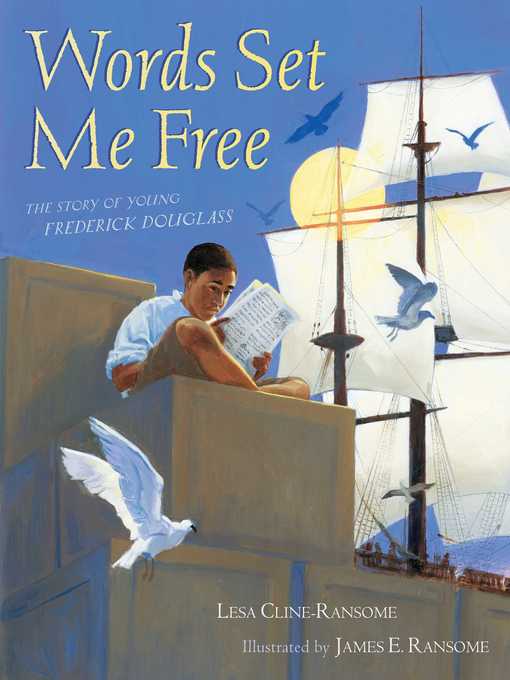
Words Set Me Free
The Story of Young Frederick Douglass
فرمت کتاب
ebook
تاریخ انتشار
2012
Lexile Score
790
Reading Level
3-4
ATOS
4.4
Interest Level
K-3(LG)
نویسنده
James E. Ransomeشابک
9781442449718
کتاب های مرتبط
- اطلاعات
- نقد و بررسی
- دیدگاه کاربران
نقد و بررسی

Starred review from November 28, 2011
Drawing from Narrative of the Life of Frederick Douglass, the Ransomes (Before There Was Mozart) create a powerful biographical account of the anti-slavery
crusader, writer, and orator’s early life. Writing from Douglass’s first-person perspective, Lesa Cline Ransome plainly relays the inhuman treatment of plantation slaves—“even the animals were rested in the heat of the afternoon sun, and they were never whipped bloody for being too tired or too sick or too slow”—and expresses how learning to read was a catalyst for Douglass’s liberation. “I bought my first newspaper and learned new words—liberty, justice, and freedom.... These were the words my master would never want me to see.” Ransome’s acrylic and oil paintings combine striking naturalism with a palette of inky greens and blues; after Douglass uses his writing skills to forge a letter from his master releasing him, a final spread shows him looking boldly toward the North Star. Though an author’s note explains that Douglass did not successfully escape that night (but did three years later), the story concludes with a sense of hope and determination. Ages 5–9.

January 1, 2012
For the enslaved child who grew up to be Frederick Douglass, learning to read led to freedom and a life of activism committed to abolition. Cline-Ransome has based her story on Douglass' autobiography, giving the gravitas and formality of the adult to the child. She describes his childhood on a Maryland plantation, including his separation from his mother and the ill treatment he and all the other enslaved children received. Sold to his owner's relatives, the Aulds, in Baltimore, Frederick Bailey, as he was then known, was taught to read from the Bible by Auld's kindly wife. When her good deed was discovered by her husband, she was forced to close her library to Frederick. Undeterred, he practiced reading on the streets and along the waterfront. Ransome uses acrylic and oil paints to create a palette rich in the blues and greens of the Chesapeake region. The portrait on the back cover is particularly striking. Husband and wife have been frequent, successful collaborators, and this title is equally commendable. One caveat, though: Ending with Douglass' successful escape rather than a failed one would have been preferable. A solid effort that offers young readers a glimpse into the lives of children in the time of slavery and appreciate the development of a most notable life. (author's note, bibliography, timeline) (Picture book/biography. 6-10)
(COPYRIGHT (2012) KIRKUS REVIEWS/NIELSEN BUSINESS MEDIA, INC. ALL RIGHTS RESERVED.)

Starred review from January 1, 2012
Gr 2-5-This powerful, eloquent first-person narrative provides a moving account of Douglass's early life. Born and raised on plantations, he spent his formative years in Baltimore in the 1820s and '30s. His thirst to learn to read never waivered; he practiced writing with a brick and a lump of chalk, copying the letters of poor white children and stealing a copybook from his master's son. At 12-years-old, Douglass bought his first newspaper with tips he had earned. He copied words like "liberty," "justice," "freedom," and "abolition" and was inspired. Though this account ends with a hopeful plan to escape, an author's note reveals that he was unsuccessful but that he did escape in 1838 to New York, where he began his new life as an abolitionist leader. This talented team has created a concise, accessible, beautifully illustrated book based on Douglass's Narrative of the Life of Frederick Douglass. Rich acrylic and oil paintings depict plantation life (poorly clothed slave children kneeling before troughs, devouring cornmeal mush like livestock) and the strong emotions of the people (a young Frederick being transported with hands tied behind his back, lest he escape). This handsome volume is recommended for slightly older audiences than William Miller and Cedric Lucas's Frederick Douglass: The Last Day of Slavery (Lee & Low, 1995).-Barbara Auerbach, PS 217, Brooklyn, NY
Copyright 2012 School Library Journal, LLC Used with permission.

March 15, 2012
Grades 2-4 From birth and early separation from his mother to his first escape attempt at age 17, this picture-book adaptation of Frederick Douglass' autobiography depicts the emotional turmoil and dehumanization of slavery. As the title suggests, the focus is on the forbidden act of reading. Taught by a well-meaning Missus, his lessons were suddenly halted with the warning, If you teach him how to read, there would be no keeping him. It would forever unfit him to be a slave. Teaching other slaves to read, Douglass devised a way to escape using his ability to write, and the adaptation ends with this clever scheme. An author's appended note reveals the attempt failed, but three years later, Douglass succeeded. Realistic acrylic and oil paintings portray harsh images of slavery. Cows graze in the field as slaves eat their meal from a trough. In a dramatic scene, young Frederick sits high on dock bales quietly reading by moon glow as unaware wealthy men walk below. Short enough for reading aloud in one session, this handsome retelling is an inspiring resource for primary-school classes and older reluctant readers.(Reprinted with permission of Booklist, copyright 2012, American Library Association.)

























دیدگاه کاربران